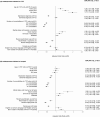Setting of initiation and factors associated with antidepressant use on entry to long-term care facilities
- PMID: 39888093
- PMCID: PMC12122125
- DOI: 10.1111/bcp.16403
Setting of initiation and factors associated with antidepressant use on entry to long-term care facilities
Abstract
Aims: Antidepressant use increases around long-term care facility (LTCF) entry, and initiation during hospitalizations may contribute to this. This study characterized the care setting (i.e., community-based, hospital or LTCF) where antidepressants were initiated and determined associated resident characteristics.
Methods: A cross-sectional study including non-Indigenous individuals aged 65-105 years who entered LTCFs in two Australian states during 2015-2019, and were dispensed an antidepressant within 2 months, was conducted. Care settings (community-based, hospital or LTCF) were determined from linked LTCF records, and hospitalizations ≤30 days before LTCF entry. Pharmaceutical claims before and after LTCF entry were screened to determine antidepressant initiation. Multivariate multinomial logistic regression estimated adjusted odds ratios (aORs) and 95% confidence intervals (95% CIs) for resident characteristics associated with care settings of antidepressant initiation.
Results: This study included 34 525 residents from 1046 LTCFs. Overall, 27 160 (78.7%) commenced antidepressants prior to entry, 2552 (7.4%) in hospital and 4813 (13.9%) in LTCFs. Mirtazapine constituted 44.8% (n = 1143) of antidepressants initiated in hospitals and 39.5% (n = 1902) in LTCFs. Residents who were aged ≥90 years were more likely to start an antidepressant in the LTCF compared to community-based settings (aOR = 1.97, 95% CI 1.74-2.23). Residents recently using a psychotropic were more likely to start an antidepressant in community-based settings before LTCF entry, compared to a hospital or LTCF.
Conclusions: Individuals receiving antidepressants during transition to LTCFs are often already taking antidepressants prior to entry. Future interventions to optimize antidepressant use in LTCFs should consider setting, recency and indication for antidepressant initiation, and ongoing monitoring for safety.
Keywords: aged; antidepressant; hospital; long‐term care; mirtazapine; nursing home.
© 2025 The Author(s). British Journal of Clinical Pharmacology published by John Wiley & Sons Ltd on behalf of British Pharmacological Society.
Conflict of interest statement
J.K.S. is a non‐executive director of Southern Cross Care SA, NT, VIC (an aged care provider organization). There are no other competing interests to declare.
Figures




Similar articles
-
Utilisation of mobile X-ray services by residents of long-term care facilities.Intern Med J. 2025 Jun;55(6):951-958. doi: 10.1111/imj.70034. Epub 2025 Mar 24. Intern Med J. 2025. PMID: 40125877 Free PMC article.
-
Antidepressants for depression in adults with HIV infection.Cochrane Database Syst Rev. 2018 Jan 22;1(1):CD008525. doi: 10.1002/14651858.CD008525.pub3. Cochrane Database Syst Rev. 2018. PMID: 29355886 Free PMC article.
-
Interventions for preventing and reducing the use of physical restraints for older people in all long-term care settings.Cochrane Database Syst Rev. 2023 Jul 28;7(7):CD007546. doi: 10.1002/14651858.CD007546.pub3. Cochrane Database Syst Rev. 2023. PMID: 37500094 Free PMC article.
-
Antidepressants for pain management in adults with chronic pain: a network meta-analysis.Health Technol Assess. 2024 Oct;28(62):1-155. doi: 10.3310/MKRT2948. Health Technol Assess. 2024. PMID: 39367772 Free PMC article.
-
Social Participation Among Older Adults Before and After Long-Term Care Facility Entry.JAMA Intern Med. 2025 Aug 4:e253684. doi: 10.1001/jamainternmed.2025.3684. Online ahead of print. JAMA Intern Med. 2025. PMID: 40758370
References
MeSH terms
Substances
Grants and funding
LinkOut - more resources
Full Text Sources
Medical

